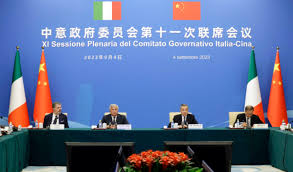Chinese-Italian collaboration boosts Italy’s economic development

The European sovereign debt crisis that erupted in 2009 spread rapidly from Greece to Italy. In the decade that followed, weak international demand and sluggish European economic recovery hindered Italy’s economic recovery. Internally, plans for infrastructure upgrades and the transition of emerging industries were poorly executed. Externally, there was minimal improvement in foreign trade and investment scale.
The EU solidarity seemed to be merely empty promises for Italy. After several unsuccessful attempts to seek the EU’s support in funding, Italy turned to China.
In 2019, the two countries signed the “Joint Communiqué of the People’s Republic of China and the Republic of Italy on Strengthening the Comprehensive Strategic Partnership,” as well as a series of important economic and trade cooperation agreements. This marked the beginning of a new stage of deep-level economic and trade collaboration between China and Italy.
Since 2019, Sino-Italian economic and trade cooperation has flourished.
Italy’s advantageous industries such as agriculture, machinery, chemicals and tourism have targeted the vast consumer market in China, and exports to China have grown rapidly, with growth rates surpassing those of Germany, China’s largest trading partner in the EU.
China’s projects in Italy – such as the reconstruction of the Port of Genoa, the high-speed railway tunnel project between the Sicilian cities of Messina and Catania, the Beleolico offshore wind farm project and the Manduria 7MW PV (photovoltaic) plant – have been successfully launched. Some projects have already been completed and started operations.
It is safe to say that the deepening of Sino-Italian economic and trade cooperation has provided new drivers for the Italian economy.
On the one end, it has expanded Italy’s export market. Constrained by weak international demand and a sluggish European economy, demand for Italian products in European and American markets has dwindled. In contrast, trade cooperation between China and Italy has blazed new trails for Italian exports. In 2023, Italian exports to China surged by 16.7 percent which is quite an impressive growth rate.
On the other end, it has propelled the transformation and upgrading of Italy’s infrastructure. At the same time, in the field of renewable energy transformation, China has outstanding advantages to assist Italy in achieving its carbon neutrality goals.
Amid the European energy crisis and economic downturn, Italy registered an economic growth rate of 0.9 percent in 2023, up slightly on the government’s forecast.
In terms of the driving force behind economic growth, the northeastern and central regions of Italy, home to numerous Chinese projects, experienced the highest growth rates. The construction industry, with the engagement of many Chinese projects, was the primary driver.
It is fair to say that Italy’s recent economic rise among western European countries and its robust recovery would not have been possible without the assistance of Sino-Italian cooperation.
Editor’s note: Yang Chengyu is an associate researcher at the Institute of European Studies of the Chinese Academy of Social Sciences. The article reflects the author’s opinions and not necessarily the views of CGTN. It has been translated from Chinese and edited for brevity and clarity.




